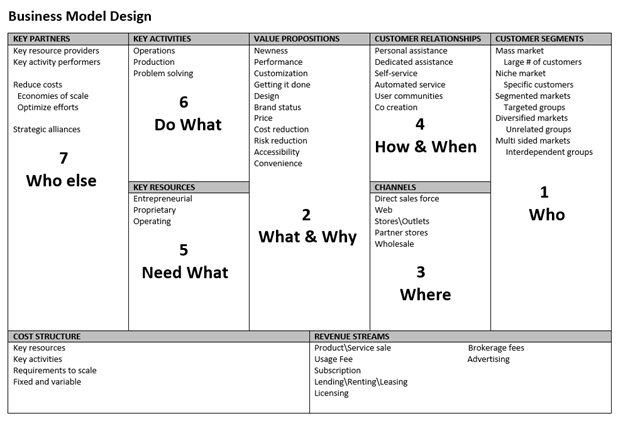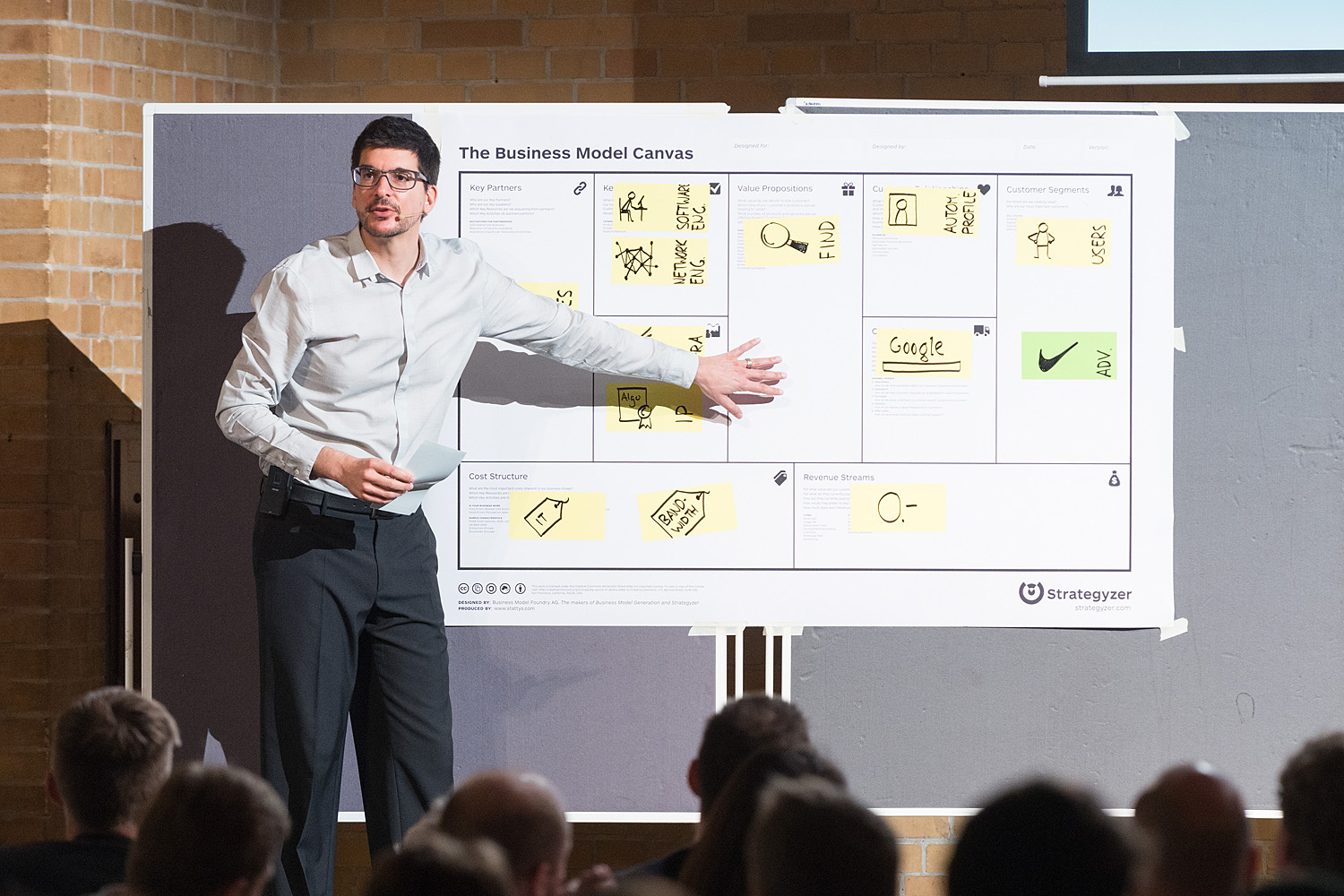Marketing is an art and science of promoting a product to an audience. But before promoting anything, you have to understand the essence of the product. This is where the Business Model Canvas comes into play. Even though the model is commonly applied to mainstream marketing, it can be useful for affiliate marketing too. Publishers, affiliates, and advertisers can improve their line of work by dividing complex business activities into simple components. This in turn helps to highlight the weak points in any project, helping to devote the resources correctly and fix the issues swiftly.
Business Model Canvas 101
Created by Alexander Osterwalder and Yves Pigneur, the Business Model Canvas includes 9 blocks that constitute an enterprise. This model is helpful to visualize what is happening on your platform, landing page, or offer database.
Each segment corresponds to a specific part of a business. This business can apply to an enterprise, platform, website, or even personal life. To make the model work for you, the info in each segment must answer a certain set of questions:
- Customer Segments: Who are the customers and what do they feel, think, see, do?
- Value Propositions: Why to buy the product? What makes it compelling?
- Channels: How VP is promoted, delivered, and sold? Does it work?
- Customer Relationships: How do you interact with the user through their journey?
- Revenue Streams: How do you generate revenue from the VP?
- Key Activities: How do you engage with the customers to deliver VP?
- Key Resources: What are the assets that make you competitive?
- Key Partners: What can be outsourced, so that you focus more on key activities? Who are the partners and suppliers?
- Cost Structure: What are the main cost drivers and how are they linked to the revenue streams?
Your business flows go from the left segments to the right ones but it’s easier to start filling in the gaps in the opposite direction. Time to explore nine segments in-depth to better understand how the model complements the affiliate marketing.
Customer segments
Don’t generalize like the majority does! Who is your core audience? What do they do? Why would they be interested in your product? Try to create a customer persona, by specifying the ideal age, gender, demographics, industry, pain points, aspirations etc.
Assume you’re promoting a betting offer. You might have a few customer segments with different core values, making the personas not interchangeable. Your GEO of choice might be India. What are the facts about potential clients there? The segment of mobile phones is large and continues to grow, the share of males approximates 51%, cricket is a national sport, Facebook is the most popular platform, and IPL 2023 is about to commence.
Therefore, one of the personas you can have is a 35-years-old man with a mobile phone, who is a cricket fan with a suboptimal income, fancying the idea of getting rich quickly.
Value propositions
Think about why should the client buy your product and not go to a competitor. Value proposition is about solving a client’s problem or closing the need. You also have to understand what makes your product to stand out.
If we get back to the persona crafted earlier, the Indian guy can enjoy personalized ads, deposit making with a familiar payment system, or a bonus system like topping up the first deposit with free funds. Alternatively, you can aim for better user experience and add support to several official languages in India: Hindi, Bengali, Marathi, and others.
Channels
Distribution channels are the points of contact with the clientele. A sale is not the end of interaction, because this segment includes everything from informing to customer support. For starters, think about the following:
- Informing: how the value proposition is delivered to the customer?
- Rating: how the product stands against the competition?
- Sale: how the purchase is made, which model is used?
- Delivery and adaptation: how exactly the product is delivered to the customer, and how the initial impression is generated?
- Customer service: how the after-sales service is conducted?
Continuing the example, Facebook, Google, and WhatsApp are among the most optimal platforms for India. Your betting offer has a plethora of payment systems, plus freebies like some bonus funds. Conversion fires once the user makes his first deposit (CPA). As for the delivery, the user gets emotions, which are transferred instantaneously; thus a good first impression of using the product can be attributed to convenience, easy-to-navigate interface, or free funds after the first deposit is depleted.
Customer relationships
First off, understand whether you want to communicate with the audience and for how long. Relationships structure depends on the business goals. Some examples of the interactions:
- Engaging for a single-time sale (home improvement, or something expensive)
- Collaborating regularly (betting, dating, and other recurring interactions)
- Segmenting the market for greater focus on narrower niches (nutra, gaming, utilities)
Betting and gambling can get repetitive, which is why in this example, it is better to build up the communication around several rounds of interactions. Your client’s first visit might yield no deposit, but you do have to grab the attention, so there is a desire to come back.
Revenue streams
Depending on what you do for living in affiliate marketing, your revenue streams can take different forms and combinations: CPM, CPC, straight sales, subscription fee, RevShare. To direct your revenue streams in the right way, you need to answer the following questions:
- What is the clientele willing to pay for?
- What are the clients paying for now?
- Which methods of payment do they use?
- Which methods would they prefer?
- How large is the contribution of each stream to the total profit flow?
As for our example, you are most likely to get paid on a cost-per-action basis. Moreover, you are not the one to discuss the pricing model. But you are not limited to a single advertiser/ affiliate network and can always have a pack of them in reserve, some of which might prefer RevShare. Sometimes, if you are good at what you are doing, you can negotiate custom terms with the dedicated manager.
Key resources
Name all the assets needed for successful operating and scaling. Which resources help you deliver value proposition to the customers, maintain the contact with them, and profit from your line of work. Specify also how each asset is obtained. Here are four most popular asset categories:
- Tangible assets: physical objects like materials, hardware, points of sale
- Intangible assets: goodwill, software, brand rights
- Staff: marketers, designers, managers, workers, AI (tribute to ChatGPT)
- Finances: money, investments, loans
You just need to figure out what helps to create value, establish relationships, discover sales channels, and maintain all of them. If you are an affiliate working alone, then you are most likely to rely on a set of software, like photo editors, translators, AI image generators. Do you really require all of them? Perhaps there are less expensive alternatives? If you have an idea that something can be automated, most likely it has already been done — just ask Google.
Key activities
Resources answer the question “What?”. Now it’s time to answer the question “How?”. How does your business operate? How do you do your job?
In case your final product is tangible, then assure smooth resource acquisition for it, efficient work of equipment, its quality control. If you are providing a service (like in our betting example), then describe approaches to work, knowledge management system, diagnostic measures, methods of monitoring customer’s satisfaction. If, however, your business is about providing the infrastructure, like a media platform, then describe the new functions implementations, testing, user support, and user experience management.
Key partners
Name everything you outsource and prefer not to do on your own. An affiliate network does the hard work of contacting the direct advertisers. Are you satisfied, or do you feel like you can do better searching for the suppliers directly? Perhaps you can start publishing the content yourself, if you feel like being an influencer? Answer the following questions:
- Which partners help minimize your risks?
- Who can be your supplier and who cannot?
- Which activities can be outsourced without damaging the product quality?
This way, you can discard all the irrelevancies and maximize your own efficiency, whether you drive traffic, publish ads, place ads, or do something else.
Cost structure
While delivering value proposition, you incur costs inevitably. It does not have to be cash, it can be time, materials, favors — but they all can be converted into money. Answer these questions:
- Which costs directly or indirectly are related to making the product?
- What resources constitute the largest portion of cost structure?
- What activities are the most expensive for us?
Make sure to group all the costs of yours into fixed and variable ones. This way, you can start figuring out the ways to implement the economy of scale, by doing more using the same volume of fixed costs.
Conclusion
Business model canvas is just a tool, which is helpful to understand where you and your business stand. It does not provide a strategy for improvement, but it does facilitate generating one.
Within its core lies the very basic idea of dividing complex tasks into trivial components. This tool is great, because it can be applied to almost anything, including the affiliate marketing. Assess your platform performance with it, monitor your website KPI, or simply process your personal life through it to see where there is a room for improvement. This way, you will focus on what’s important, instead of spreading your resources everywhere.
If you want to reach new GEOs and audiences, maybe it is all waiting for you on Telegram? We’ve prepared some material about Telegram audiences. What are the messenger’s users like this year? How old they are, what they do, and what they are interested in!







